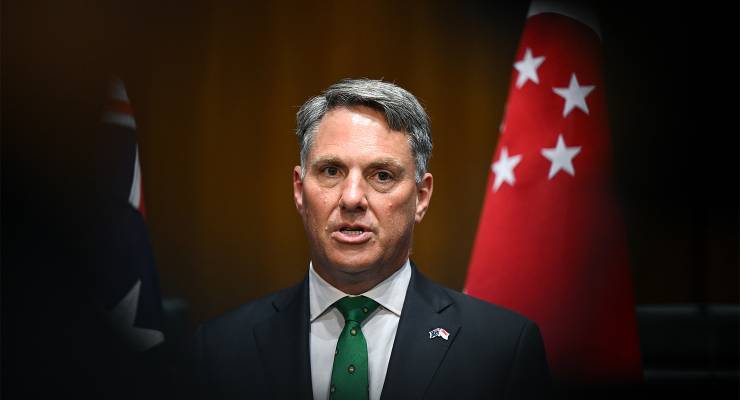
The federal government has admitted it has no idea how much the total cost of the AUKUS program will be.
A Defence Department statement about “fiscal risks” contained in Tuesday’s budget says it’s currently impossible to calculate the total cost of the nuclear-powered submarine program.
“The total costs associated with the program will not be known until design and production processes are settled and commercial and other arrangements are finalised between governments and delivery partners,” the statement says.
The cost over the next four financial years was estimated at $9 billion, and “between $50 billion and $58 billion over the medium term”.
“Overall, the cost of the nuclear-powered submarine program is expected to amount to around 0.15% of annual GDP per year, averaged out to 2054-55,” the budget paper says.
Defence Minister Richard Marles said in written comments handed to reporters that increased military spending was “in line with the strategic circumstances” Australia finds itself in.
“The Albanese government has made no secret that we’re willing to make the hard decisions in order to get the best outcome for our [defence force],” he said.
Other costly defence projects in the budget include $4.1 billion for “long-range strike capabilities”, $3.8 billion for “northern base infrastructure”, $400 million for a new bonus to defence personnel, and $900 million on defence innovation.
Marles and three other ministers who share responsibility for Australia’s defence said in a joint statement that the government’s support for the recent Defence Strategic Review would represent “the most substantive transformation of defence in over 30 years”.
The statement said a “whole-of-government and whole of-nation uplift” was needed to “defend not only the nation, but our interests”.
The budget papers reveal some details of how the initial implementation of the AUKUS program will be financed.
“The government will provide $4.5 billion over 10 years from 2023-24 (and $482.7 million per year ongoing) to support the initial steps in Australia’s acquisition of a conventionally armed, nuclear-powered submarine capability,” the budget papers say.
“This forms part of the whole-of-program costs over the decade.”
Establishing and running a new Australian Submarine Agency, which will manage the program, is estimated to cost $4.2 billion over a decade.
Included in that cost will be $15.3 million over the same period to establish an independent monitor and adviser “to provide independent assurance for the [program] through periodic health checks and proactive advice”.
The project will involve creating 4000 new Commonwealth-supported university places to build the skills necessary to operate the submarine program ($127.3 million over four years). At least 800 of those places will be allocated to South Australian universities.
Regulating the program and developing non-proliferation arrangements will cost $87.2 million over two years.
That work will involve establishing an Australian Nuclear-Powered Submarine Safety Regulator ($7.9 million), setting up safeguard arrangements with the International Atomic Energy Agency ($21.9 million over two years), and figuring out what to do with radioactive waste ($5.2 million over two years).
The Health Department will also get $3.1 million in funding to “provide radiation health and safety advice”.
Other work that needs to be done before the program gets up and running includes developing international treaties ($2.4 million over two years) and providing Foreign Affairs with “international policy advice and diplomatic support” ($52.7 million over two years).
The government will also inject equity into a firm called Australian Naval Infrastructure Pty Ltd with a view to begin designing and building a submarine construction yard.
The cost of that move is being kept secret due to “commercial sensitivities”.








A Government Project demanding huge investment to achieve nothing more than a boondoggle of expenses. Where is the outcry from our economic gatekeepers? As the young boy cries, Minister Marles has no cloths on.
Meanwhile, one street back behind the high rises I walk past and greet the homeless as they shuffle off to the known community organizations for their nourishment.
I guess fighting a faux enemy is more deserving than our citizens down on their luck.
How much of this will include consultancy fees from Mr. Pyne, Mr. Hockey Mr. Brandis and now perhaps Mr. Morrison. Could Mr. Morrison take on all roles, so we can save on the other three influencers?
“That work will involve establishing an Australian Nuclear-Powered Submarine Safety Regulator ($7.9 million), setting up safeguard arrangements with the International Atomic Energy Agency ($21.9 million over two years), and figuring out what to do with radioactive waste ($5.2 million over two years).” Spending $5.2 million to think about radioactive waste. The answer is simple. Leave the uranium in the ground.
Yes Peter, this massive injection of support for the US military/industrial complex seems designed to obfuscate any serious investigation into the financial details. Hiding behind secrecy, now including “commercial sensitivities” as well as “commercial
in confidence”, and loudly supported by the mainstream press, the Canberra hawks are on a winner. When this beatup began by the new defence minister, it was touted as no risk nuclear, because the power plants are “sealed for life”, and remain the property of the US. Just a few short months later, there is a nuclear waste problem for Australia. Behind the scenes, there is a slew of retired US Navy admirals being paid huge sums daily for their expertise. The fox is in charge of the pen. All presented as a valid, responsible, necessary response to an imaginary threat by an emerging military superpower, to protect our “Sovereignty” and “National Security”.
Not any clearer on the makeup of numbers after reading this article.
If the claim of 0.15% of GDP over the course of next 30 years is correct, the total cost should be around $100B and not $368B.
It just doesn’t add up.
We’ll be increasing our national debt by 40% if the reported estimated costs hold up. Having seen how other projects have blown their budget, we’re likely to face much larger impact.
Is it really worth it?
Best thing about AUKUS and the submarines are that probably neither will go anywhere. Worst thing about AUKUS and the submarines is how much their dismal failure will cost – us, never the politicians – before they don’t go anywhere.
Observe that absolutely nobody is calling for the tax giveaways to be diverted to pay the cost! Politicians are one set of bunnies NOT paying for this folly. Filthy rich, another!
For once an article in “The Australian” got it right: “Nuke subs will arrive much too late to help us in conflict / We are not doing enough to address the immediate dangers in our region.”
New Zealand will be enormously relieved that its non-nuclear status allowed it to avoid this nightmare.